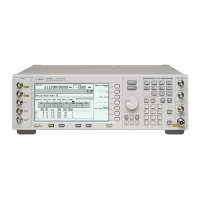96 Chapter 4
Basic Digital Operation
Arbitrary (ARB) Waveform File Headers
3. Return to the ARB Setup menu: Press Return.
You are now in the
ARB Setup softkey menu. From this menu you can access all the signal generator
settings that are saved to the file header. However, not all ESG settings are saved to the file header. For
example, the
ARB Reference Ext Int softkey selection is not part of the saved header settings. Figure 4-3
shows the ARB Setup softkey menu and the softkey paths used in steps four through nine.
Runtime Scaling: The Runtime scaling value. Runtime scaling is applied in real-time while the waveform is
playing. This setting can be changed only for files playing in the dual ARB player.
Marker 1...4 Polarity: The marker polarity, positive or negative (described on page 144).
ALC Hold Routing: Which marker, if any, implements the ESG’s ALC hold function (described on page 131).
The ALC hold function holds the ALC at its current level when the marker signal is low.
All waveforms generated in the ESG have a marker on the first sample point. In order to
see the results from the three routing selections, you may need to select a range of sample
(marker) points. Setting the marker points is accomplished using the Set Marker on Range
of Points softkey located in the Marker Utilities softkey menu. See “Setting Marker Points
in a Waveform Segment” on page 137 for more information.
Alt Ampl. Routing This will display which marker, if any, triggers the ESG’s alternate amplitude feature when
the marker signal is low. When the marker signal goes high, the trigger is terminated,
disengaging alternate amplitude. You still need to configure the alternate amplitude
parameters located in the Amplitude hardkey menu.
RF Blank Routing: Which marker, if any, implements the ESG’s RF blanking function (described on page
142) when the marker signal is low. RF blanking also uses ALC hold. There is no need to
select the ALC Hold Routing for the same marker when you are using the RF Blank
Routing function. When the marker signal goes high, RF blanking is discontinued.
High Crest Mode This field displays the status of the high crest mode for the dual ARB player. The high crest
mode reduces ALC levels while playing ARB waveform files, resulting in the maximum
output level but reducing power level accuracy. This setting can only be changed for files
in the dual ARB player.
Mod Attenuation: The I/Q modulator attenuation setting.
I/Q Mod Filter: The I/Q modulator filter setting. The modulator filter affects the I/Q signal modulated onto
the RF carrier.
I/Q Output Filter: The I/Q output filter setting. The I/Q output filter is used for I/Q signals routed to the rear
panel I and Q outputs.

